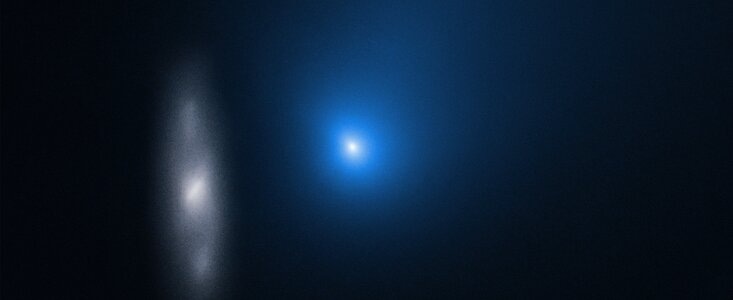Dec 13 2019
Once again, the NASA/ESA Hubble Space Telescope has taken a snapshot of comet 2I/Borisov flashing through the Solar System on its way back into interstellar space.
 Comet 2I/Borisov and distant galaxy in November 2019. Image Credit: NASA, ESA, and D. Jewitt (UCLA).
Comet 2I/Borisov and distant galaxy in November 2019. Image Credit: NASA, ESA, and D. Jewitt (UCLA).
Borisov moves at an overwhelming speed of more than 175,000 km per hour, which makes it one of the fastest comets to be ever observed. It is just the second interstellar object known to have streaked through the Solar System.
The comet was observed by Hubble in October 2019, at a distance of roughly 420 million kilometers from Earth. These new observations of the comet made in November and December 2019 at a closer distance offer a clearer understanding of the dimensions and details of the interstellar visitor.
In one of the images, the comet is seen in front of a distant background spiral galaxy (2MASX J10500165-0152029). The bright central core of the galaxy is smeared in the image since Hubble was tracking the comet. In this exposure, Borisov was located roughly 326 million kilometers from Earth. Its tail of discharged dust streaks off to the upper right.
Another image shows Hubble’s revisit observation of the comet close to its nearest approach to the Sun. There, it underwent a higher degree of heating than it had ever been subjected to, after spending a major part of its life in the extreme cold of interstellar space. In this image, the comet is located 298 million kilometers from Earth, close to the inner edge of the asteroid belt.
The nucleus, which is an accumulation of dust and ices, is still too tiny to be resolved. The central portion, which is very bright, is a coma formed of dust that leaves the surface. The comet will come closest to Earth in late December, when it will be located at a distance of 290 million kilometers.
“Hubble gives us the best measure of the size of comet Borisov’s nucleus, which is the really important part of the comet,” stated David Jewitt, a professor of planetary science and astronomy at the University of California Los Angeles, whose group has taken the best and sharpest images of this first interstellar comet.
Surprisingly, our Hubble images show that its nucleus is more than 15 times smaller than earlier investigations suggested it might be. The radius is smaller than half a kilometre. This is important because knowing the size helps us to determine the total number, and mass, of such objects in the Solar System, and in the Milky Way. Borisov is the first known interstellar comet, and we would like to know how many others there are.
David Jewitt, Professor of Planetary Science and Astronomy, University of California Los Angeles
The comet was discovered by Gennady Borisov, a Crimean amateur astronomer, on August 30th, 2019. Following observations by professional and amateur astronomers from across the globe for a week, the Minor Planet Center of the International Astronomical Union computed an orbit for the comet, which revealed that it entered from interstellar space.
To date, the origin of all registered comets has been a ring of icy debris located at the periphery of the Solar System, known as the Kuiper belt, or the Oort cloud, a shell of icy objects considered to be located in the outermost regions of the Solar System, where its innermost edge is about 2000 times the distance between the Sun and the Earth.
2I/Borisov might be just the start of a series of discoveries of interstellar objects making a brief visit to the Solar System. At any given time, there could be thousands of such interstellar objects in the Solar System. However, a majority of them are too faint to be spotted with existing telescopes.
After observations by Hubble and other telescopes, it has been found that shells and rings of icy debris surround young stars where planet formation is ongoing. A gravitational interaction between such comet-like objects and other huge bodies could make them plunge deep into space, where they get drifted among the stars.